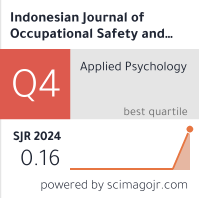Indoor Air Factors Affecting the Growth of Microorganism in an Indonesian Gas Company's Dormitory

Downloads
Introduction: Mold may affect the Indoor Air Quality (IAQ) in workplace dormitories. This study aims to investigate indoor air factors that affect molds growth in a dormitory of an LNG Company in Indonesia. Several indoor air determinant factors, including relative humidity, general temperature, wet temperature, dry temperature, air velocity, illumination, particulate matter, and carbon dioxide concentration were assessed against the growth of microorganism colonies. Methods: This study was a cross-sectional study using a 2 (two)-stage Andersen sampler based on NIOSH 0800 Bioaerosol Sampling Method for Indoor Air Quality for viable bioaerosol sampling. Bioaerosol samples were collected from 50 indoor, corridor, and outdoor sampling points. The total colony count for bioaerosols (TCC) was then determined (CFU/m3). Ten indoor air quality parameters, i.e., relative humidity, general temperature, wet temperature, dry temperature, air velocity, illumination, particulate matter, and carbon dioxide concentration, were measured. Results: The average mold colony concentration in the dormitory rooms was higher (703.1 CFU/m3) than the maximum standard issued by the Ministry of Health of the Republic of Indonesia (< 700 CFU/m3) while the relative humidity was very high (84.4% RH on average), with a direct relation between the humidity and the mold colony concentration. A significant correlation was also identified between mold colony concentration, wet temperature, and CO2 concentration. Conclusion: Significant correlations between bioaerosols, relative humidity, wet temperature, and indoor CO2 concentration indicate insufficient ventilation and poor indoor air quality in the dormitory.
Araujo, R. and Cabral, J. P. (2010) ‘Fungal Air Quality in Medical Protected Environments', in Kumar, A. (ed.) Air Quality. London: IntechOpen, pp. 357–382.
Chegini, F. M. et al. (2020) ‘Indoor and Outdoor Airborne Bacterial and Fungal Air Quality in Kindergartens: Seasonal Distribution, Genera, Levels, and Factors Influencing their Concentration', Building and Environment, 175, p. 106690.
Dang, D. Y. N. et al. (2020) ‘Microbiological contamination of indoor air in university classrooms(Case study: University of Science - Vietnam National University,Ho Chi Minh city)', Vietnam Journal of Science, Technology and Engineering, 62(4), pp. 30–35.
Degois, J. et al. (2021a) ‘Indoor Air Quality Assessment in Dwellings with Different Ventilation Strategies in Nunavik and Impacts on Bacterial and Fungal Microbiota', Indoor Air: International Journal of Indoor Environment and Health, 31(6), pp. 2213–2225.
Degois, J. et al. (2021b) ‘Indoor Air Quality Assessment in Dwellings with Different Ventilation Strategies in Nunavik and Impacts on Bacterial and Fungal Microbiota', Indoor Air: International Journal of Indoor Environment and Health, 31(6), pp. 2213–2225.
Dudzinska, M.R. (2011) Management of Indoor Air Quality. London: CRC Press.
Enitan, S.S. et al. (2017) ‘Microbiological Assessment of Indoor Air Quality of Some Selected Private Primary Schools in Ilishan- Remo, Ogun state, Nigeria', International Journal of Medical and Health Research, 3(6), pp. 8–19.
Fujiyoshi, S., Tanaka, D. and Maruyama, F. (2017) ‘Transmission of Airborne Bacteria Across Built Environments and its Measurement Standards: A Review', Frontiers in Microbiology, 8(Nov), pp. 1-17.
Garcia-Cela, E. et al. (2020) ‘Carbon Dioxide Production as an Indicator of Aspergillus Flavus Colonisation and Aflatoxins/Cyclopiazonic Acid Contamination in Shelled Peanuts Stored Under Different Interacting Abiotic Factors', Fungal Biology. British Mycological Society, 124(1), pp. 1–7.
Giri, S. K. (2020) ‘Prevalence Of Air-Borne Fungi in Indoor Environment of Dental Clinic', International Research Journal of Modernization in Engineering, Technology and Science, 2(8), pp. 1161–1169.
Leite Júnior, D. P. et al. (2018) ‘Indoor Air Mycological Survey and Occupational Exposure in Libraries in Mato Grosso-Central Region”Brazil', Advances in Microbiology, 08(04), pp. 324–353.
Lim, A. Y. et al. (2021) ‘Effects of Mechanical Ventilation on Indoor Air Quality and Occupant Health Status in Energy-Efficient Homes: A Longitudinal Field Study', Science of the Total Environment, 785, pp. 1-6.
Lindsley, W. G. et al. (2017) ‘NIOSH Manual of Analytical Methods: Sampling and Characterization of Bioaerosols'. 5th Edition.Washington DC: Department of Health and Human Services.
Mannan, M. and Al-Ghamdi, S. G. (2021) ‘Indoor Air Quality in Buildings: A Comprehensive Review on the Factors Influencing Air Pollution in Residential and Commercial Structure', International Journal of Environmental Research and Public Health, 18(6), pp. 1–24..
Mata, T. M. et al. (2022) ‘Indoor Air Quality in Elderly Centers : Pollutants Emission and Health Effects', Environments, (2), pp. 1–25.
Mentese, S. et al. (2020) ‘A Long-term Multi-Parametric Monitoring Study: Indoor Air Quality (IAQ) and the Sources of the Pollutants, Prevalence of Sick Building Syndrome (SBS) Symptoms, and Respiratory Health Indicators', Atmospheric Pollution Research. Turkish National Committee for Air Pollution Research and Control, 11(12), pp. 2270–2281.
NIOSH NMAM. (1998) ‘Bioaerosol Sampling (Indoor Air) Culturable Organisms: Bacteria, Fungi, Thermophilic Actinomycetes', NMAM 0800 Methods, (1), p. 800.
Özkan, V. K. (2020) ‘Fungal Bioaerosols in Indoor Air Environments of Health Services Vocational School in Marmaris, Turkey', Mantar Dergisi: The Journal of Fungus, 11(1), pp. 50–56.
Pavlík, M. et al. (2020) ‘Evaluation of the Carbon Dioxide Production by Fungi Under Different Growing Conditions', Current Microbiology, 77(9), pp. 2374–2384.
Regulation of the Minister of Health Of the Republic of Indonesia. (2011). Regulation of the Minister of Health of the Republic of Indonesia No 1077/Menkes/PER/2011 on Guideline for Healthy Indoor Air.
Saadati, Z. et al. (2022) ‘Investigation of Indoor and Outdoor Fungal Bioaerosols and Environmental Factors in Indoor Air Quality of Nursery Schools', International Journal of Molecular and Clinical Microbiology, 12(1), pp. 1596–1604.
Sa'id, A.S. and Salihu, A.A., 2017 ‘Microbiological Quality of Indoor Air in Some Selected Buildings at Modibbo Adamawa University of Technology, Yola', Journal of Microbiology, 3(1), pp.1-5.
Spicer, N. (2015) ‘Global Health Global Health', JAMA: Journal of the American Medical Association, 42(3), pp. 89–99.
Stojanović Bjelić, L., Ilić, P. and Farooqi, Z. U. R. (2020) ‘Indoor Microbiological air Pollution in the Hospital', Quality of Life (Banja Luka) - APEIRON, 18(1–2), pp. 5–10.
Tang, W., Kuehn, T. H. and Simcik, M. F. (2015) ‘Effects of Temperature, Humidity and Air Flow on Fungal Growth Rate on Loaded Ventilation Filters', Journal of Occupational and Environmental Hygiene, 12(8), pp. 525–537.
Vornanen-Winqvist, C. et al. (2020) ‘Exposure to Indoor Air Contaminants in School Buildings with and without Reported Indoor Air Quality Problems', Environment International, 141(October), p. 105781.
Zautner, A. E., Frickmann, H. and Podbielski, A. (2021) ‘Risk assessment for Molds in the Vicinity of a Child Requiring Peritoneal Dialysis Living in a Rural Northern German Area', Microorganisms, 9(11), pp. 1–12.
Zavieh, F. S. et al. (2021) ‘Assessment of Types of Bacterial Bio-Aerosols and Concentrations in the Indoor Air of Gyms', Environmental Geochemistry and Health, 43(5), pp. 2165–2173.
Zender-Åšwiercz, E. et al. (2019) ‘The Microbiology Contaminants and Microclimate Parameters in the Nursery Building', International Journal of Environmental Science and Technology. , 16(11), pp. 6699–6704.

This work is licensed under a Creative Commons Attribution-NonCommercial-ShareAlike 4.0 International License.

In order to be accepted and published by The Indonesian Journal of Occupational Safety and Health, Author(s) who submit an article should complete all the review process. The copyright of received articles assigned to the The Indonesian Journal of Occupational Safety and Health and Department of Safety and Health, Universitas Airlangga as publishers of the journal. The intended copyright includes the rights to publish articles in various forms (including reprints).
The Editorial Team of The Indonesian Journal Of Occupational Safety and Health and Department of Safety and Health strive to ensure that no errors occur in the articles that have been published, both data errors and statements in the article.
Users of this website will be licensed to use materials from this website following the Creative Commons Attribution-NonCommercial-ShareAlike 4.0 International License. No fees charged. Please use the materials accordingly.
------------------------------------------------------------------------------------------------------------------------------------------------------------------------------------------
Attribution ” You must give appropriate credit, provide a link to the license, and indicate if changes were made. You may do so in any reasonable manner, but not in any way that suggests the licensor endorses you or your use.
NonCommercial ” You may not use the material for commercial purposes.
ShareAlike ” If you remix, transform, or build upon the material, you must distribute your contributions under the same license as the original.







 How to Submit Articles in OJS
How to Submit Articles in OJS

























